"Joy in looking and comprehending is nature's most beautiful gift"
About this Quote
Albert Einstein’s observation reveals a profound truth about the human experience and our relationship with the world around us. At its core, the statement celebrates the intrinsic satisfaction and wonder found in observing and understanding the secrets of nature. Unlike material possessions or fleeting pleasures, the joy derived from genuinely looking, truly seeing, rather than merely glancing, and from seeking to comprehend the workings of the universe is unique and enduring.
This joy arises from both curiosity and a sense of connection. When individuals pause to look at a flower, contemplate a distant star, or study patterns in an ecosystem, they are engaging in an act that is both intellectual and emotional. The ability to comprehend, to move from confusion to clarity, provides a sense of personal growth and accomplishment. It’s as though nature offers an inexhaustible source of mysteries, and the act of unraveling even a small portion of them generates wonder and fulfillment.
Einstein’s perspective emphasizes that such joy is accessible to everyone, not only to scientists or scholars, but to anyone willing to observe and think deeply. Nature’s "gift" does not discriminate; it’s not bestowed upon a select few, but available to all who pay attention and ponder. The more one looks and seeks understanding, the more layers nature reveals, each bringing its own delight.
Moreover, this joy goes beyond personal satisfaction. It fosters humility and appreciation for the universe’s complexity and beauty. As understanding deepens, so does a sense of awe for forces larger than oneself. In finding beauty in the interconnectedness of nature’s processes, in patterns, structures, and laws, people are reminded of their place in the grand tapestry of existence.
Ultimately, through looking and comprehending, individuals access a form of happiness that nurtures the spirit, cultivates mindfulness, and encourages a lifelong relationship with learning and discovery.
More details
About the Author

